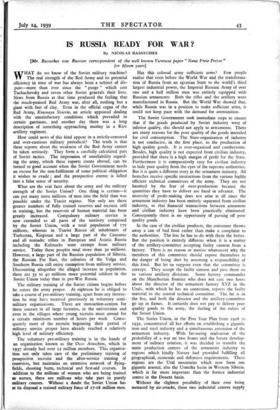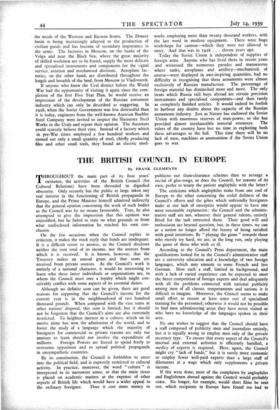IS RUSSIA READY FOR WAR ?
By NICOLAS BASSECHES
[Mr. Basseches was Russian correspondent of the well known Viennese paper " Neue Freie Presse" or fifteen years] WHAT do we know of the Soviet military machine? The real strength of the Red Army and its potential efficiency in time of war has always been a subject of dis- pute—more than ever since the " purge " which cost Tuchachevsky and seven other Soviet generals their lives.
News from Russia at that time produced the feeling that the much-praised Red Army was, after all, nothing but a giant with feet of clay. Even in the official organ of the Red Army, Krasnaya Sviesta, an article appeared dealing with the unsatisfactory conditions which prevailed in certain garrisons, and another day there was a long description of something approaching mutiny in a Kiev artillery regiment.
How could news of this kind appear in a strictly-censored and over-cautious military periodical? The truth is that these reports about the weakness of the Red Army cannot be taken seriously. They form a carefully calculated part of Soviet tactics. The impression of unreliability regard- ing the army, which these reports create abroad, can be turned to good account when the Soviet Government needs an excuse for the non-fulfilment of some political obligation it wishes to evade ; and the prospective enemy is lulled into a false sense of security.
What are the real facts about the army and the military strength of the Soviet Union? One thing is certain—it can put many more millions of men into the field than was possible under the Tsarist regime. Not only are there greater numbers of fully trained reserves and recruits still in training, but the reservoir of human material has been greatly increased. Compulsory military service is now extended to all parts of the territory comprised by the Soviet Union, with a total population of 170 millions, whereas in Tsarist Russia all inhabitants of Turkestan, Kirgistan and a large part of the Caucasus and all nomadic tribes in European and Asiatic Russia including the Kalmucks were exempt from military service. Today these peoples total more than 3o millions.
However, a large part of the Russian population of Siberia, the Russian Far East, the colonists of the Volga and Southern Russia still enjoy exemption from military service.
Discounting altogether the alleged increase in population, there are 35 to 40 millions more potential soldiers in the Soviet Union today than in pre-War Russia.
The military training of the Soviet citizen begins before he enters the army proper. At eighteen he is obliged to take a course of pre-military training, apart from any instruc- tion he may have received previously in voluntary semi- military organisations. There are instruction-centres for these courses in all large factories, in the universities and even in the villages where young recruits must attend for a certain minimum number of hours per week. Conse- quently most of the recruits beginning their period of military service proper have already reached a relatively high level of military efficiency.
The voluntary pre-military training is in the hands of an organisation known as the Osso Aviochim, which in 1937 already had over 12 million members. This organisa- tion not only takes care of the preliminary training of prospective recruits and the after-service training of reservists, but maintains an extensive network of flying- fields, shooting butts, technical and first-aid courses. In addition to the millions of women who are being trained as nurses, there are millions who take part in purely military courses. Without a doubt the Soviet Union has at its disposal a trained military force of 17-18 million men. Has this colossal army sufficient arms? Few people realise that even before the World War and the transforma- tion of Russia from an agrarian State to the world's third largest industrial power, the Imperial Russian Army of over one and a half million men was entirely equipped with Russian armaments. Both the rifles and the artillery were manufactured in Russia. But the World War showed that, while Russia was in a position to make sufficient arms, it could not keep pace with the demand for ammunition.
The Soviet Government took immediate steps to ensure that if the goods produced by Soviet industry were of inferior quality, this. should not apply to armaments. There are many reasons for the poor quality of the goods intended for civil consumption. The State-organisation of industry is not conducive, in the first place, to the production of high quality goods. It is over-organised and cumbersome. Besides, high quality is not expected from civilian industry, provided that there is a high margin of profit for the State. Furthermore it is comparatively easy for civilian industry to hide poor quality from the eyes of the supreme authorities. But it is quite a different story in the armament industry. All branches receive specific instructions from the various highly efficient technical committees of the army. They are not haunted by the fear of over-production because the quantities they have to deliver are fixed in advance. The necessity of profit-making does not arise at all since the armament industry has been entirely separated from civilian industry, so that financial transactions between armament and civilian industry have been practically eliminated. Consequently there is no opportunity of passing off poor quality goods.
In the case of the civilian products, the consumer throws away a can of bad food rather than make a complaint to the authorities. The less he has to do with them the better. But the position is entirely different when it is a matter of the artillery-committee accepting faulty cannon from a factory. There is no reason or motive whatsoever why the members of this committee should expose themselves to the danger of being shot by assuming a responsibility of this kind. But let us suppose even that the committee is corrupt. They accept the faulty cannon and pass them on to various artillery divisions. Some battery commander on the Manchurian frontier who does not care two hoots about the director of the armament factory XYZ in the Urals, with which he has no connexion, reports the faulty material to the central technical committee. The fat is in the fire, and both the director and the artillery-committee go up in flames. It certainly does not pay to deliver poor quality goods to the army, the darling of the rulers of the Soviet Union.
The Soviet Union, in the Five Year Plan from 1928 to 1932, concentrated all her efforts on establishing a gigantic iron and steel industry and a simultaneous extension of the armament industry. With far-seeing realisation of the probability of a war on two fronts and the future develop- ment of military aviation, it was decided to transfer the main production centres of the armament industry to regions which kindly Nature had provided fulfilling all geographical, economic and defensive requirements. These regions are the Ural mountains which now form one gigantic arsenal, also the Usnezka basin in Western Siberia, which is far more important than the former industrial centre in the Donetz basin.
Without the slightest possibility of their ever being menaced by air-attacks, these two industrial centres supply the needs of the Western and Eastern fronts. The Donetz basin is being increasingly adapted to the production of civilian goods and has become of secondary importance to the army. The factories in Moscow, on the banks of the Volga and near the Black Sea, where the great majority of skilled workmen are to be found, supply the more delicate and specialised instruments and components for the signal service, aviation and mechanised divisions. Aeroplane fac- tories, on the other hand, are distributed throughout the length and breadth of the land, from Moscow to Vladivostok.
If anyone who knew the Ural district before the World War had the opportunity of visiting it again since the com- pletion of the first Five Year Plan, he would receive an impression of the development of the Russian armament industry which can only be described as staggering. In 1928, when the Soviet Government was less distrustful than it is today, engineers from the well-known Austrian Boehler Steel Company were invited to inspect the Slatauster Steel Works in the Urals and report their opinion. The Austrians could scarcely believe their eyes. Instead of a factory which in pre-War times employed a few hundred workers and turned out only a small quantity of steel, chiefly producing files and other small tools, they found an electric steel- works employing more than twenty thousand workers, with the last word in modern equipment. There were huge workshops for cannon—which they were not allowed to enter. And that was in 5928 . . . eleven years ago.
Today the Soviet Union is independent of supplies of foreign arms. Anyone who has lived there in recent years and witnessed the numerous parades and manoeuvres where tanks, aeroplanes and artillery—mechanised, of course—were displayed in awe-inspiring quantities, had no difficulty in recognising that these armaments were almost exclusively of Russian manufacture. The percentage of foreign material has diminished more and more. The only items which Russia still buys abroad are certain precision instruments and specialised components—and then rarely as completely finished articles. It would indeed be foolish to harbour any doubts about the capacity of the Russian armaments industry. Just as Nature has endowed the Soviet Union with enormous reserves of man-power, so she has provided almost inexhaustible material resources. The rulers of the country have lost no time in exploiting both these advantages to the full. This time there will be no lack of men, machines or ammunition if the Soviet Union goes to war.











































 Previous page
Previous page